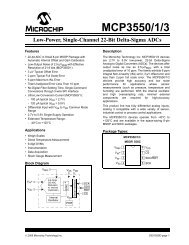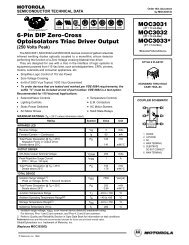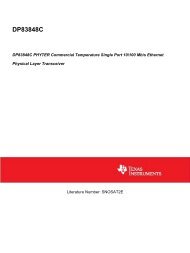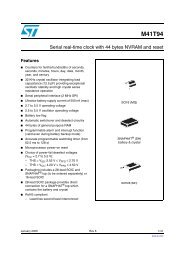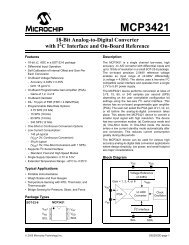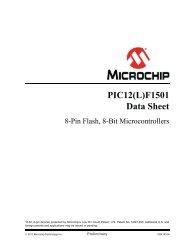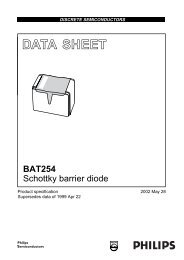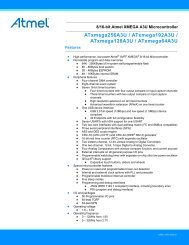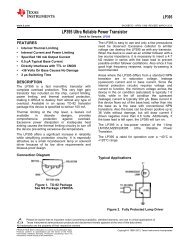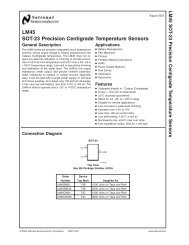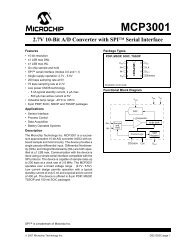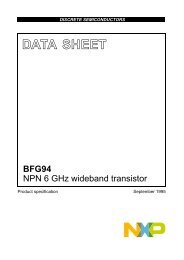pic24fj128ga010 family - Microchip
pic24fj128ga010 family - Microchip
pic24fj128ga010 family - Microchip
Create successful ePaper yourself
Turn your PDF publications into a flip-book with our unique Google optimized e-Paper software.
PIC24FJ128GA010 FAMILY2.0 CPUNote:This data sheet summarizes the features ofthis group of PIC24F devices. It is notintended to be a comprehensive referencesource. Refer to Section 2. “CPU”(DS39703) in the “PIC24F Family ReferenceManual” for more information.The PIC24F CPU has a 16-bit (data) modified Harvardarchitecture with an enhanced instruction set, and a24-bit instruction word with a variable length opcodefield. The Program Counter (PC) is 23 bits wide andaddresses up to 4M instructions of user programmemory space. A single-cycle instruction prefetchmechanism is used to help maintain throughput andprovides predictable execution. All instructions executein a single cycle, with the exception of instructions thatchange the program flow, the double-word move(MOV.D) instruction and the table instructions.Overhead-free program loop constructs are supportedusing the REPEAT instructions, which are interruptibleat any point.PIC24F devices have sixteen 16-bit working registersin the programmer’s model. Each of the workingregisters can act as a data, address or address offsetregister. The 16th working register (W15) operates asa Software Stack Pointer for interrupts and calls.The upper 32 Kbytes of the data space memory mapcan optionally be mapped into program space at any16K word boundary defined by the 8-bit ProgramSpace Visibility Page (PSVPAG) register. The programto data space mapping feature lets any instructionaccess program space as if it were data space.The Instruction Set Architecture (ISA) has been significantlyenhanced beyond that of the PIC18, butmaintains an acceptable level of backward compatibility.All PIC18 instructions and addressing modes aresupported either directly or through simple macros.Many of the ISA enhancements have been driven bycompiler efficiency needs.The core supports Inherent (no operand), Relative,Literal, Memory Direct and three groups of addressingmodes. All modes support Register Direct and variousRegister Indirect modes. Each group offers up to7 addressing modes. Instructions are associated withpredefined addressing modes depending upon theirfunctional requirements.For most instructions, the core is capable of executinga data (or program data) memory read, a working register(data) read, a data memory write and a program(instruction) memory read per instruction cycle. As aresult, three-parameter instructions can be supported,allowing trinary operations (that is, A + B = C) to beexecuted in a single cycle.A high-speed, 17-bit by 17-bit multiplier has beenincluded to significantly enhance the core arithmeticcapability and throughput. The multiplier supportssigned, unsigned and Mixed mode 16-bit by 16-bit or8-bit by 8-bit integer multiplication. All multiplyinstructions execute in a single cycle.The 16-bit ALU has been enhanced with integer divideassist hardware that supports an iterative,non-restoring divide algorithm. It operates in conjunctionwith the REPEAT instruction looping mechanism,and a selection of iterative divide instructions, tosupport 32-bit (or 16-bit) divided by 16-bit integersigned and unsigned division. All divide operationsrequire 19 cycles to complete but are interruptible atany cycle boundary.The PIC24F has a vectored exception scheme with upto 8 sources of non-maskable traps and up to118 interrupt sources. Each interrupt source can beassigned to one of seven priority levels.A block diagram of the CPU is shown in Figure 2-1.2.1 Programmer’s ModelThe programmer’s model for the PIC24F is shown inFigure 2-2. All registers in the programmer’s model arememory mapped and can be manipulated directly byinstructions. A description of each register is providedin Table 2-1. All registers associated with theprogrammer’s model are memory mapped.© 2009 <strong>Microchip</strong> Technology Inc. DS39747E-page 21



